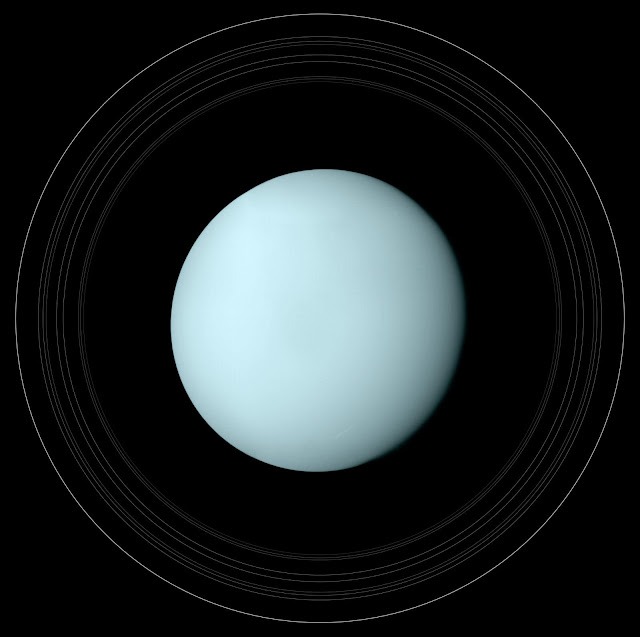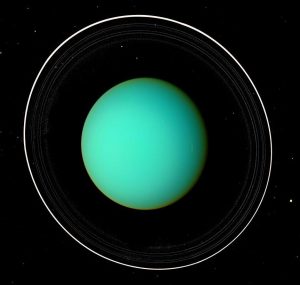Uranus Revisited?
In April this year, a group of influential scientists spoke to NASA about future planetary space missions.
Their number one recommendation is a spacecraft to visit Uranus.
Their vision is a space probe to go into orbit around Uranus.
It would investigate the planet and take a close look at some of its moons.
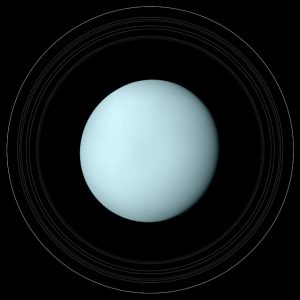
Uranus & rings. Credit: NASA
The recommendation is made in a document published by the US National Academies of Sciences, Engineering, and Medicine (NAS).
Known as a “decadal survey”, it summarizes ideas from the American research community.
They look at big planetary science questions and the space missions required to answer them.
The group’s previous recommendations in 2011 included a mission to Mars to return rock samples.
As a result, the Perseverance rover is now on the red planet.
They also suggested a probe to study Jupiter’s moon Europa.
That launch is scheduled for 2024.
So the decadel suggestions do result in action.
Voyager
The only previous space probe to visit Uranus was Voyager 2 in 1986.
It was a flyby on its way to Neptune and out of the Solar System.
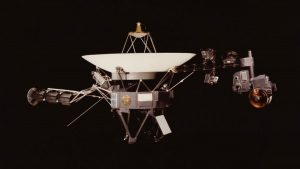
Voyager spacecraft. Credit: NASA
Voyager flew within 82,000 km (51,000 miles) of the surface.
It studied five big moons and discovered eleven others.
During the flyby it took 7,000 images.
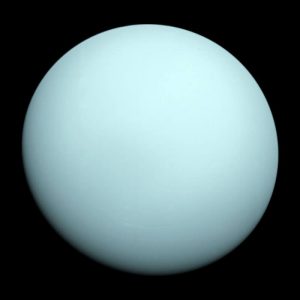
Uranus. Credit: NASA
They remain our best views of this distant world and its moons.
Now, says the decadel survey, it is time to plan a return visit.
Quick Facts
- Astronomer William Herschel discovered Uranus in 1781.
- Uranus is the seventh planet in order from the Sun.
- Distance: almost 3 billion km from the Sun.
- Orbit: Uranus takes 84 years to go around the Sun.
- Diameter: 50,000 km.
- Day length: 17 hours.
- Rotation: Uranus spins on its side, its axis titled by 98 degrees.
- Nature: an ‘ice giant’ made of ammonia, methane and water ices around a rocky core.
- Rings: 13 thin dusty rings circle the planet.
- 27 moons: named after characters created by William Shakespeare and Alexander Pope.
Why go back?
Now is a good time to plan a mission to Uranus.
In 2031 and 2032, Jupiter will be in the right position to give a spacecraft a ‘gravity slingshot’ on to its target.
Even so, the probe will take 13 years to reach Uranus.
So we may have to wait until the year 2044 to see new close-up images of the seventh planet.
What might you be doing in 2044?
Crucially, it will not be another flyby mission.
The robotic craft will go into orbit around the planet.
The new probe will explore Uranus in unprecedented detail.
The findings will tell us more about the formation of the Solar System
They may also help us understand why so many exoplanets – planets orbiting other stars – are similar in size to Uranus and Neptune.
It will also investigate the moons, some of which may have water beneath an icy surface.
And, of course, where there is water there is a chance of life.
A planet on its side
Uranus is tilted over so much that its poles are where the equator should be,
The axis is tilted by 98 degrees.
In its 84 years orbit, each hemisphere has 42 years of sunlight followed by 42 years of darkness.
Strange seasons!
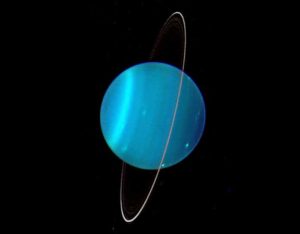
Uranus and rings. Credit: NASA
It is likely that another planet crashed into Uranus when the Solar System was young, some 4 billion years ago.
The impact knocked the planet onto its side.
The Moons
Uranus has five major moons: Miranda, Ariel, Umbriel, Titania, and Oberon.
Miranda
The innermost of the five big moons is Miranda.
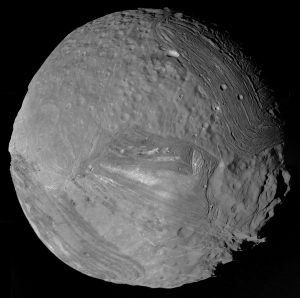
Miranda from Voyager 2. Credit: NASA
Miranda is made mostly of water ice.
Its icy surface is criss-crossed by huge canyons.
Cliffs on Miranda are the highest in the Solar System, reaching up to 20km high.
Ariel
The next moon is Ariel, made of rock and ice in equal amounts.
Surface features include cratered areas, flat plains, ridges and canyons.
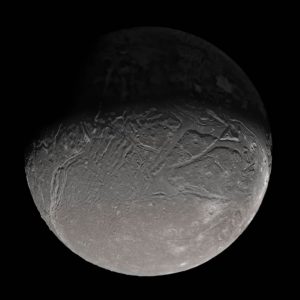
Ariel from Voyager 2. Credit; NASA
Umbriel
Like Ariel, Umbriel is made of rock and ice.
Its surface is very dark and heavily cratered.
The white rings around big craters may be deposits of material from the impacts.
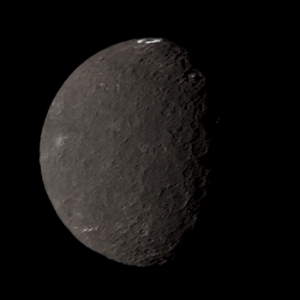
Umbriel from Voyager 2. Credit: NASA
Titania
Titania is the largest moon of Uranus at almost 1600 km across.
It probably has a rocky core surrounded by a mantle of ice.
There may be a layer of liquid water between mantle and core.
The moon’s reddish surface features include craters and canyons.
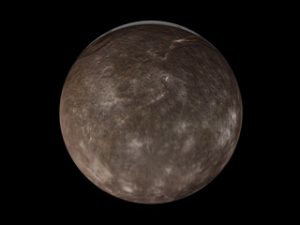
Titania from Voyager 2. Credit: NASA
Oberon
Oberon is the outermost of the big five moons.
It is made of ice and rock and red in colour.
The surface of Oberon shows impact craters and canyons.
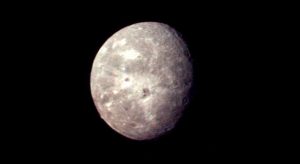
Oberon from Voyager 2. Credit: NASA
The Rings
The rings around Uranus are dark and dim.
They are only a few kilometres wide and made of dust.
They may be the remains of a moon which was smashed apart by cosmic collisions long ago.
Rings of Uranus. Credit: NASA, Hubble
Uranus: What’s in a name?
Uranus was the first planet discovered using a telescope, by William Herschel in 1781.
But Uranus is actually just visible without a telescope.
It does need a dark sky and acute vision.
The planet was recorded several times in history but as a star.
The earliest observation was probably in 128 BC, a sighting made by Hipparcos.
Astronomer Royal John Flamsteed saw Uranus in 1690, almost a century before Herschel’s discovery.
Flamsteed catalogued the planet as a star.
When Herschel first saw his new object. he thought it was a comet.
When it became clear it was a planet, Herschel named it ‘George’s Star’ for King George III.
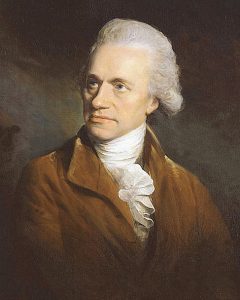
William Herschel. Photo: public domain
Although this was not popular with other astronomers, it earned Herschel a stipend of £200 a year as ‘Royal Astronomer’.
German astronomer Johan Bode came up with ‘Uranus’, after the Greek god of the sky.
And of course, Uranus is top of the snigger charts with young boys who have just learned the names of body parts.
They gleefully shout out ‘Your anus’ when they name the planets in turn.
So how should the name be pronounced?
In my Wonderdome shows, I refer to the planet as ‘Yurr-ann-uss’, a pronunciation favoured by many astronomers.
However ‘Your anus’ may be more appropriate.
The planet is a windy gas giant containing lots of methane.
The author: Dennis Ashton is a Fellow of the Royal Astronomical Society and a Wonderdome presenter.
Would you like to hear more Astronomy news?
Do you want to to find out about our upcoming public events?
Follow WonderDome Portable Planetarium on Twitter and Facebook or go to our web site wonderdome.co.uk

